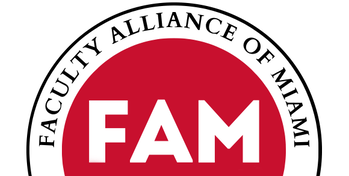The Difference a Union Makes
shared governance
|
CURRENTLY AT MIAMI: You and your colleagues devote significant time to participating in shared governance structures, but those structures offer limited opportunities for voicing your views on issues that affect your working lives.
Vertical Divider
|
THE UNION DIFFERENCE: Shared governance becomes a reality when faculty have genuine influence on decisions affecting the campus community. Unionization gives you and your colleagues the legal power to seek the conditions you need to become the teachers, librarians, and scholars you want to be.
|
Shared governance
Equity and Job Security for
Non-Tenure-Track Faculty
|
CURRENTLY AT MIAMI: More than a quarter of full-time faculty (and over half of total faculty) are non-tenure-track. Equity and job security for our valuable non-tenure track faculty is an ongoing problem at Miami.
Vertical Divider
|
THE UNION DIFFERENCE: As part of the same collective bargaining unit, all full-time faculty (including VAPs, instructors, tenure-line, and TCPL) and librarians would have an equal voice in the union.
Together with all your full-time colleagues, you have significant power to improve your working lives. You and your colleagues could negotiate raises, establish pathways for longer-term contracts, codify processes for conversions into more secure positions, clarify responsibilities and terms of promotion, and open up opportunities currently only available to tenure-line faculty. Some examples:
|
Workload
|
CURRENTLY AT MIAMI: In AAUP one-on-one conversations, workload increases have emerged as a primary concern for faculty.
Vertical Divider
|
THE UNION DIFFERENCE: A union contract can clarify workload expectations and prevent exploitation by enforcing existing workload policy. While Ohio labor law prohibits unions from bargaining directly over workload, faculty unions in Ohio have negotiated aspects of workload through both contracts and MOUs.
|
Compensation
|
CURRENTLY AT MIAMI: Results from a 2017 Miami campus climate survey indicate that 54% of faculty and administrators had considered leaving Miami; over half of those who considered leaving did so because of low compensation. In the same survey, only 17% of faculty and administrators agreed that non-tenure-track salaries at Miami were competitive.
Vertical Divider
|
THE UNION DIFFERENCE: At unionized universities in Ohio, faculty and librarians receive merit raises in addition to across-the-board raises, lifting the floor for everyone while maintaining flexibility to reward excellence. Union contracts can also address inequities such as racial and gender wage gaps and salary compression.
|
Promotion and tenure
|
CURRENTLY AT MIAMI: Lack of clarity and mentorship around promotion and tenure is a concern often expressed by our colleagues in one-on-one interviews. Miami’s Board of Trustees decided last year to add a sentence to Miami policy stating that they control decisions about tenure policy, specifically electing not to align with national norms under which policy decisions about promotion and tenure are delegated to faculty
Vertical Divider
|
THE UNION DIFFERENCE: Collective bargaining contracts protect faculty by codifying transparent procedures and expectations (while allowing for differences across disciplines and units) so that faculty and librarians seeking promotion know how to succeed.
|
Quality of Education
|
CURRENTLY AT MIAMI: Miami’s strong reputation for commitment to undergraduate teaching is declining. Total full-time faculty numbers were down by 10% in 2020. Meanwhile, enrollments increased, leading to more sections, larger classes, and a higher overall workload that prevented faculty from serving students as well as we would like. Faculty shortages and workload increases have negatively affected our students
Vertical Divider
|
THE UNION DIFFERENCE: Union contracts can negotiate specific types of support that faculty need to provide high-quality instruction. More broadly, as discussed above, contracts can include measures to promote job security, address compensation inequities and protect against bias to create a workplace where teaching can thrive.
Contracts and MOUs can clarify and enforce workload expectations, protecting Miami’s most valuable resource—faculty time—to enable engaged and enthusiastic teaching and learning. |
